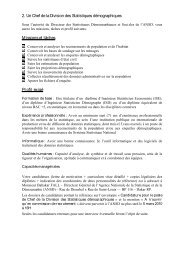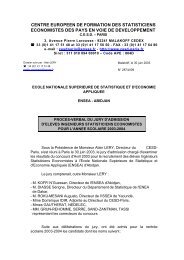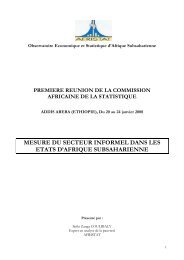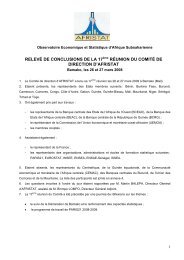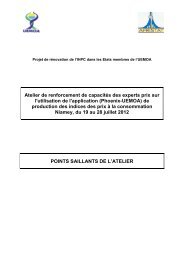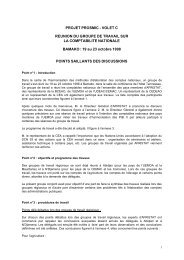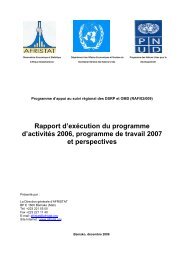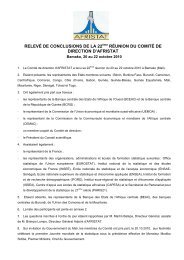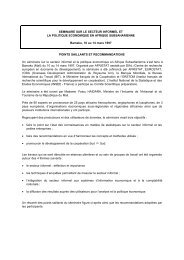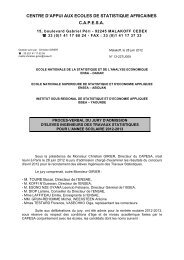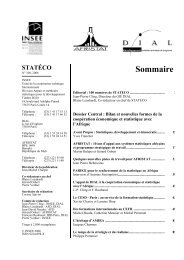Global Purchasing Power Parities and Real Expenditures - Afristat
Global Purchasing Power Parities and Real Expenditures - Afristat
Global Purchasing Power Parities and Real Expenditures - Afristat
Create successful ePaper yourself
Turn your PDF publications into a flip-book with our unique Google optimized e-Paper software.
<strong>Global</strong> <strong>Purchasing</strong> <strong>Power</strong> <strong>Parities</strong> <strong>and</strong> <strong>Real</strong> <strong>Expenditures</strong>than consumer goods in developing economies, while servicestend to be cheaper. Comparisons between economiesat this level provide another view of what is contributing todifferences in growth rates between economies.The PPP-based measures of the GDP are needed tocompare volume measures with other economic variables.Examples include the following:m Carbon emissions per unit of GDPm Energy use per unit of GDPm GDP per employeem GDP per hour workedThe first two are useful for environmental comparisons,while the latter two provide important comparisons ofproductivity.Reliability of PPPs <strong>and</strong> GDPVolume Measures<strong>Purchasing</strong> power parities are statistical estimates. Like allstatistics, they are point estimates that fall within somemargin of error of the unknown, true values. The errormargins surrounding the PPPs depend on the reliability ofthe expenditure weights <strong>and</strong> the price data <strong>and</strong> how wellthe goods <strong>and</strong> services that were priced represent the consumptionpattern <strong>and</strong> price levels of each participatingeconomy. As with national accounts data generally, it is notpossible to calculate precise error margins for PPPs or thereal expenditure data derived from them.The 2005 ICP included economies ranging from citystatesto large <strong>and</strong> diverse countries such as China, India,<strong>and</strong> Indonesia, which collectively account for more than40 percent of the world’s population <strong>and</strong> include manypeople living in remote, rural locations. These <strong>and</strong> similareconomies had to produce national average prices forgoods <strong>and</strong> services that were comparable with those ofother economies in their region. The accuracy of the PPPsfor these economies depends upon the extent to which theselected goods <strong>and</strong> services were representative of theirentire economy <strong>and</strong> on their ability to provide nationallyrepresentative average prices. The need to measure pricesfor internationally comparable goods <strong>and</strong> services meansthat they are more likely to reflect consumption patterns ofurban areas. It is also true that many household goods <strong>and</strong>services are available only in towns, so the urban <strong>and</strong> ruralprices become the same. If the urban-to-rural price differentialsare similar across economies, any bias will tend tocancel out in the estimation of PPPs; if not, results for someeconomies may be biased, up or down, depending on theextent of over- or underrepresentation of urban <strong>and</strong> ruralareas. Additional detail about estimating PPPs for largeeconomies follows in box 1.To minimize this potential bias, each ICP region preparedits own list of goods <strong>and</strong> services to be priced so thatthey would better reflect the characteristics of the economiesin its region. The need to deal with the wide diversityof sizes, urbanization, <strong>and</strong> performance of economiesin each region was considered at every step leading to theestimation of PPPs.Therefore, caution should be used when comparingeconomies by the size of their GDP or in per capita expenditures.Mindful that there may be errors in the calculationof GDP <strong>and</strong> population sizes, as well as in the estimationof PPPs, small differences should not be considered significant.It is generally accepted that differences in GDP ofless than 5 percent lie within the margin of error of thePPP estimation. Rather than ranking economies, it is preferableto group economies by broad size categories. Cautionshould also be exercised about making comparisonsof price levels or per capita expenditures at low levels ofaggregation, where small errors may lead to large discrepancies.Some areas such as housing <strong>and</strong> health are moredifficult to measure, <strong>and</strong> services in general are more difficultto price than are goods; therefore, comparisons of thesecomponents have wider measures of error than those forfood products.PPPs should not be used as indicators of the under- orovervaluation of currencies, nor should they be interpretedas equilibrium exchange rates. The PPPs cover all of GDPvalued at purchaser’s prices, which include both traded <strong>and</strong>nontraded goods. Exchange rates, unlike PPPs, reflect thedem<strong>and</strong> for currencies as a medium of exchange, speculativeinvestments, or official reserves. Exchange rates shouldbe used to price international transactions <strong>and</strong> to makecomparisons between economies of international debt, theflow of international capital, <strong>and</strong> the export <strong>and</strong> import ofgoods <strong>and</strong> services.The PPPs in this report are not comparable with previousPPPs published by the World Bank in the World DevelopmentIndicators (WDI) or other publications.



